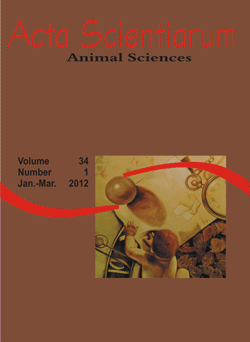<b>Performance and digestibility of Nile tilapia fed with pineapple residue bran</b> - 10.4025/actascianimsci.v34i1.12083
Abstract
Two experiments were conducted, the first being the digestibility of feed and the second performance in an attempt to evaluate the residue of pineapple bran in diets for Nile tilapia. Eighty animals weighing 63.9 ± 0.79 g in a completely randomized design were used to test the digestibility in order to evaluate the apparent digestibility of dry matter, crude protein, gross energy, digestible energy and digestible protein. In the performance of 240 juveniles were distributed in three ranges of weights: 34.9 ± 0.06, 44.4 ± 0.27 and 55.5 ± 0.10 g, in order to evaluate performance, yield Housing and somatic indices of Nile tilapia. The design was a randomized block with three blocks, with four treatments and five repetitions, rations in both experiments contained four levels of inclusion of pineapple bran residue (0, 5, 10 and 15%). The digestibility of the diets were: dry matter (76.17, 75.42, 75.31 and 75.77%), crude protein (87.90, 90.24, 89.51 and 89.03%) gross energy (79.12, 79.33, 79.07 and 77.48%), digestible energy (3649, 3559, 3560 and 3190 kcal kg-1) and digestible protein (29.28, 30.35, 29.82 and 29.79%), respectively. It was observed the significant effect on the carcass without head, so we recommend the inclusion of up to 10.39% for the inclusion of pineapple bran residue in diets of Nile tilapiaDownloads
Download data is not yet available.
Published
2011-09-22
How to Cite
Lima, M. R., Ludke, M. do C. M. M., Holanda, M. C. R., Pinto, B. W. C., Ludke, J. V., & Santos, E. L. (2011). <b>Performance and digestibility of Nile tilapia fed with pineapple residue bran</b> - 10.4025/actascianimsci.v34i1.12083. Acta Scientiarum. Animal Sciences, 34(1), 41-47. https://doi.org/10.4025/actascianimsci.v34i1.12083
Issue
Section
Nonruminant Nutrition
DECLARATION OF ORIGINALITY AND COPYRIGHTS
- I Declare that current article is original and has not been submitted for publication, in part or in whole, to any other national or international journal.
The copyrights belong exclusively to the authors. Published content is licensed under Creative Commons Attribution 4.0 (CC BY 4.0) guidelines, which allows sharing (copy and distribution of the material in any medium or format) and adaptation (remix, transform, and build upon the material) for any purpose, even commercially, under the terms of attribution.
Read this link for further information on how to use CC BY 4.0 properly.
0.9
2019CiteScore
29th percentile
Powered by 








































